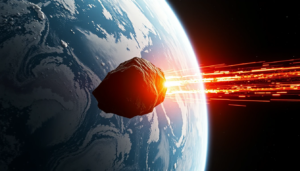A massive “city-killer” asteroid is set to pass near Earth in 2025. Learn about its trajectory, potential risks, and how NASA is tracking this cosmic threat.
The City-Killer Asteroid: A Cosmic Close Encounter
In February 2025, a massive asteroid, dubbed the “city-killer,” will make a close approach to Earth, sparking both fascination and concern among astronomers and the public. Measuring approximately 1,000 feet in diameter, this asteroid, officially named 2025 FK, has the potential to cause significant damage if it were to collide with our planet. However, NASA assures us that the chances of impact are extremely low, with a 99.99% probability of a near-miss.
Why the “City-Killer” Label?
Asteroids of this size are classified as Potentially Hazardous Objects (PHOs) due to their destructive potential. If 2025 FK were to strike Earth, it could release energy equivalent to hundreds of nuclear bombs, devastating an area the size of a major city and causing widespread climate effects. Thankfully, NASA’s advanced tracking systems have confirmed that the asteroid will safely pass by Earth at a distance of 3.5 million kilometers—about nine times the distance between Earth and the Moon.
NASA’s Vigilance: Tracking the Threat
NASA’s Planetary Defense Coordination Office (PDCO) is closely monitoring 2025 FK using a network of ground-based telescopes and space-based observatories. Programs like the Asteroid Terrestrial-impact Last Alert System (ATLAS) and the Sentinel Impact Warning System provide real-time data on the asteroid’s trajectory. “While the risk is minimal, we take every potential threat seriously,” says Dr. Emily Carter, a leading astronomer at NASA.
Countries in the Hypothetical Risk Zone
Using advanced orbital modeling, scientists have identified a narrow “risk corridor” where gravitational forces or cosmic variables could theoretically alter the asteroid’s path. Countries under this hypothetical strike zone include:
- United States (Southwest regions)
- Mexico (Northern states)
- Brazil (Amazon Basin)
- India (Southern coastal areas)
- Australia (Northern territories)
FAQ Section
Q1: What’s the probability of 2025 FK hitting Earth?
A: NASA estimates a 0.01% chance—extremely unlikely but not impossible.
Q2: How fast is the asteroid traveling?
A: Roughly 50,000 km/h, covering the Earth-Moon distance in under 7 hours.
Q3: Can we deflect it if threatened?
A: Yes! Missions like DART (Double Asteroid Redirection Test) have proven that kinetic impactors can alter an asteroid’s trajectory.
Q4: When is the next close approach?
A: 2025 FK will return in 2032, but calculations show an even safer distance.
Also read: Exploring the 2024 YR4 Asteroid: What You Need to Know
Disclaimer
This article is for informational purposes only. All data reflects NASA’s publicly available projections as of July 2024. Astronomical trajectories may shift due to unforeseen variables. No need for panic—the asteroid poses no imminent threat. Always refer to official sources like NASA.gov for updates.
